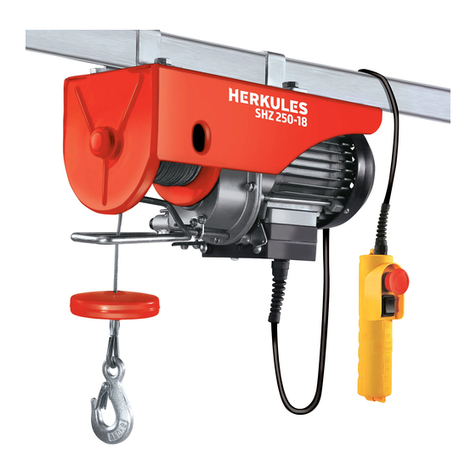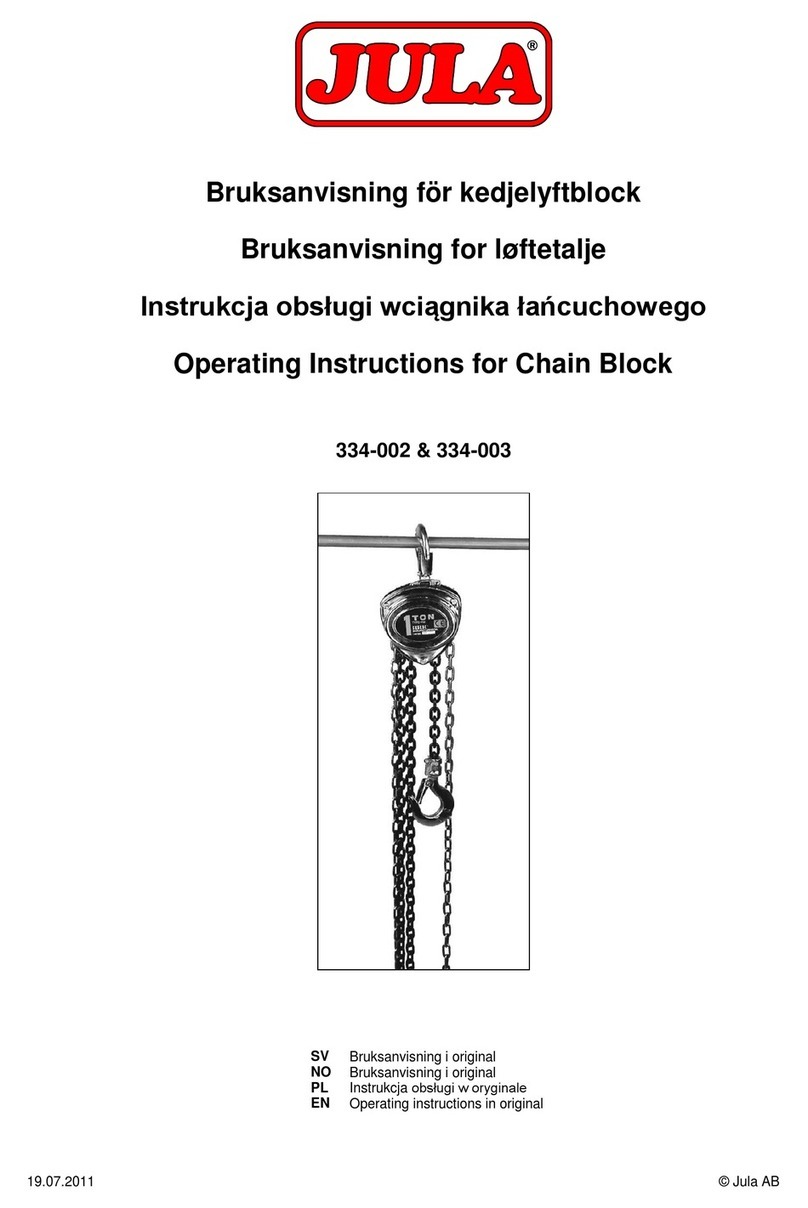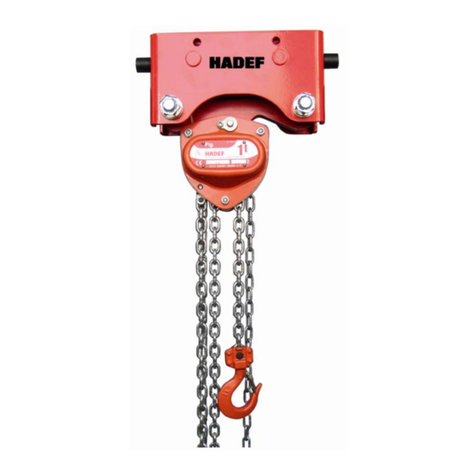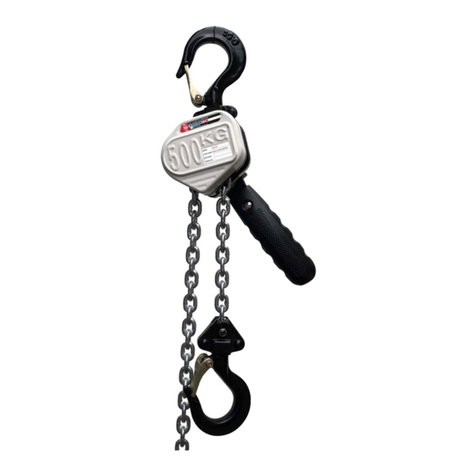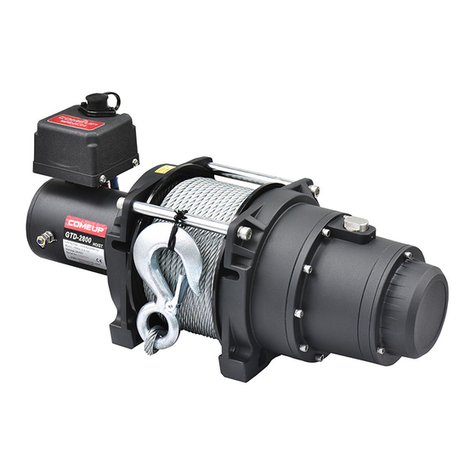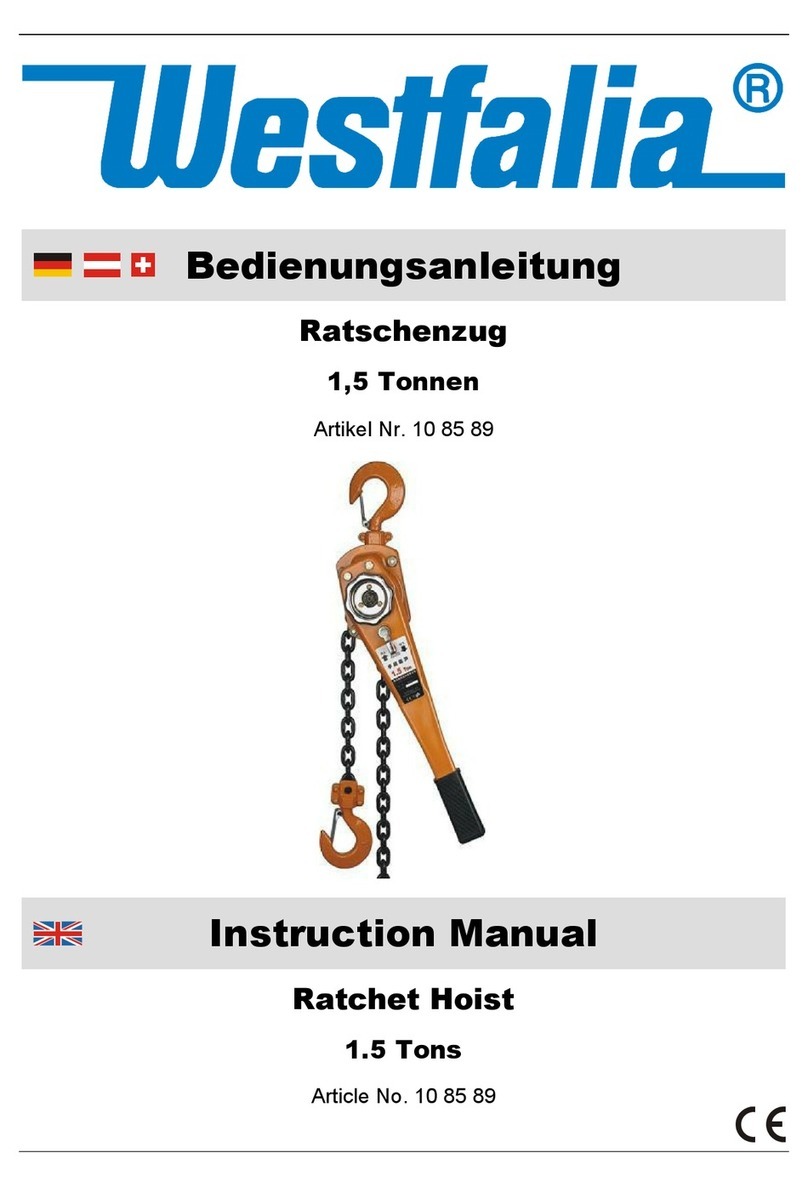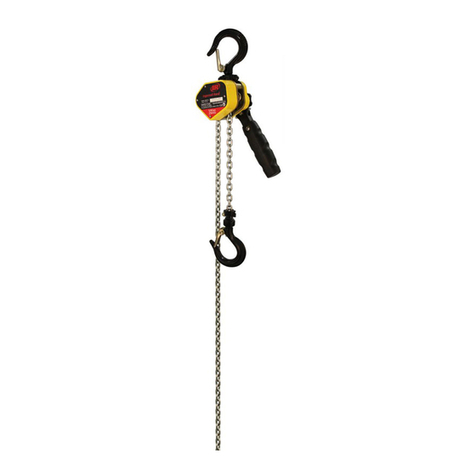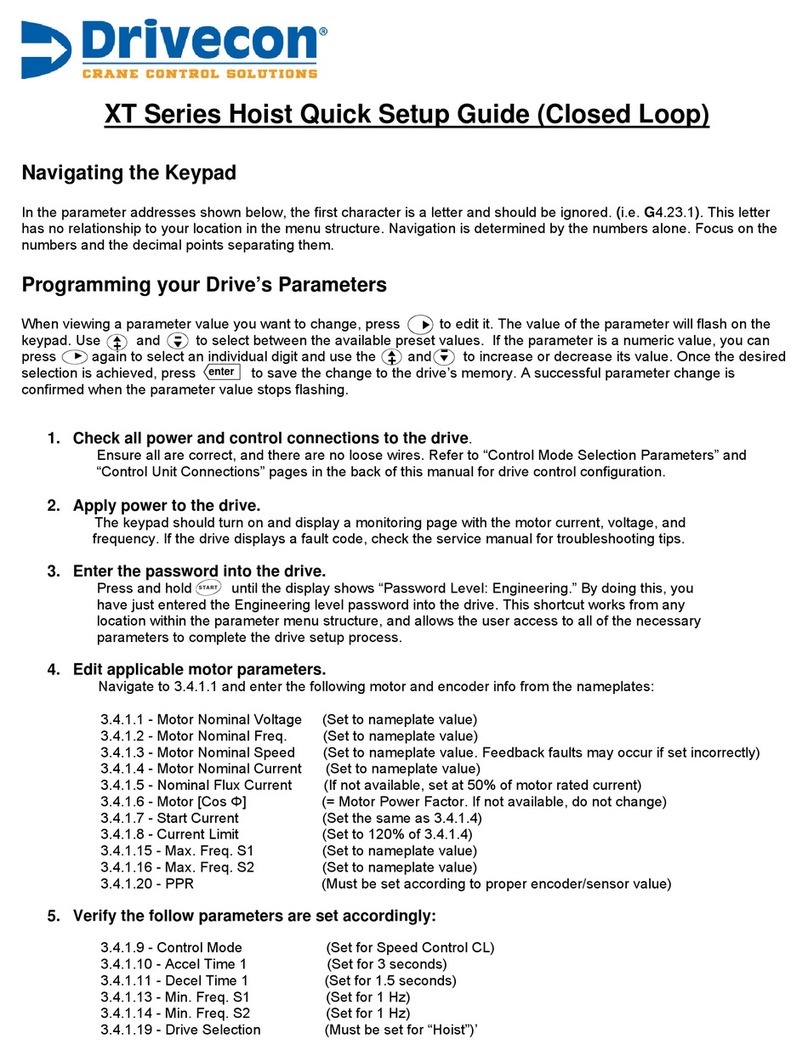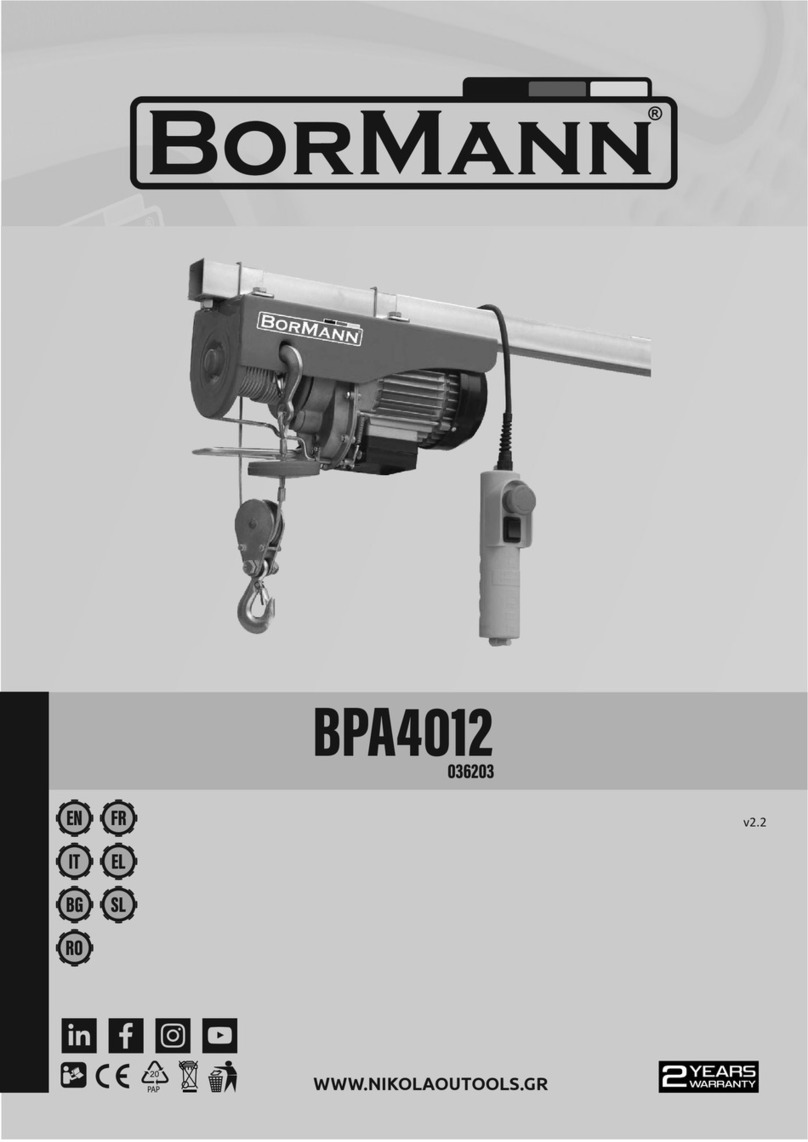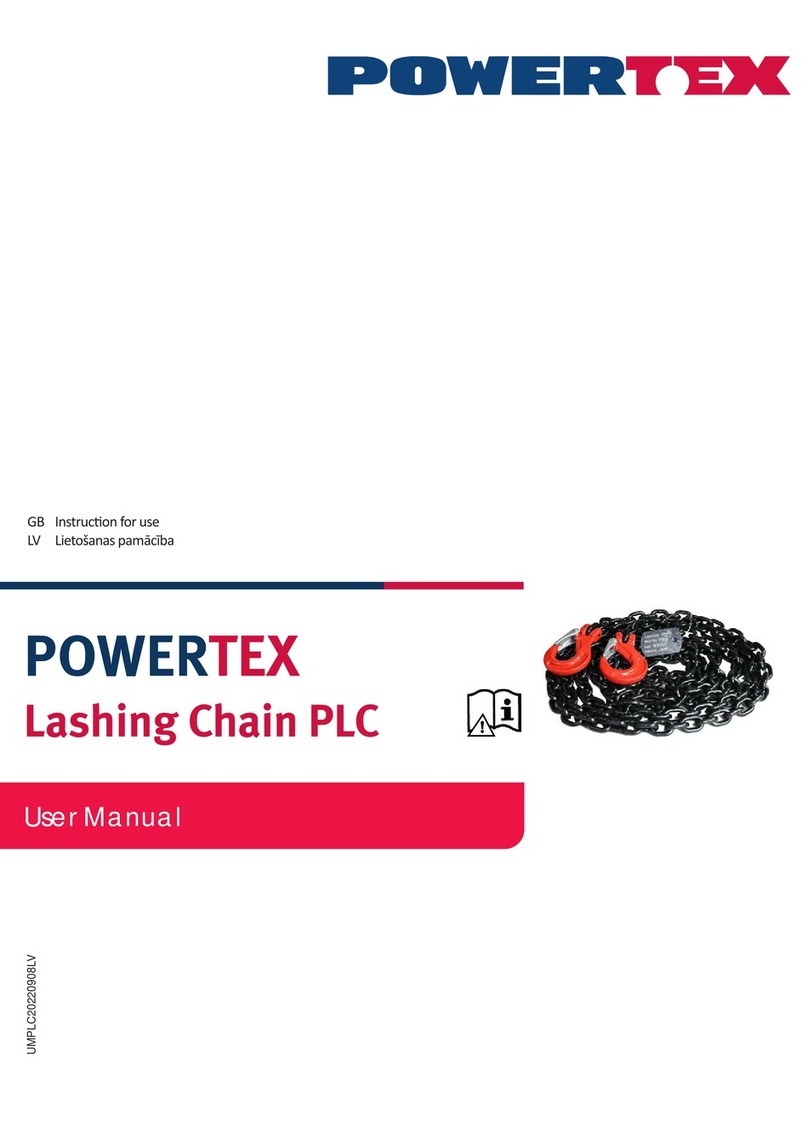Sky Climber Compact 1000 Assembly instructions

January 2019 Page 1
OPERATOR’S INSTRUCTION MANUAL
Compact 1000, 1250 & 1500 Hoists
Air & Electric Power
TO EMPLOYER AND/OR RENTAL AGENCY
It is imperative that this manual be given to the operator of Sky Climber
equipment and that they read, fully understand, and follow all instructions
contained herein.
WARNING
Any use of this equipment, other than in strict accordance with
these instructions, shall be at the Operator’s risk and
may result in serious injury to themselves or others.
REMEMBER SAFETY IS THE RESPONSIBILITY
OF BOTH YOU AND THE OPERATOR.

January 2019 Page 2
TableofContents
HOIST SPECIFICATIONS & CHARACTERISTICS......................4
HOIST OPERATIONS...................................................................5
ELECTRICAL HOISTS..................................................................6
AIR HOISTS..................................................................................6
SUSPENDED ACCESS INSTALLATION .....................................7
GUIDELINES.............................................................................................................................7
TOP SIDE RIGGING.................................................................................................................7
SKY LOCK SECONDARY BRAKE ...........................................................................................7
TYPICAL TOP SIDE RIGGING SYSTEMS...............................................................................8
WIRE ROPE..............................................................................................................................9
FALL ARREST EQUIPMENT..................................................................................................10
PLATFORMS ..........................................................................................................................11
WELDING................................................................................................................................11
STEEL ROPE REQUIREMENTS............................................................................................12
RIGGING AND REEVING.......................................................................................................13
HOIST & SKY LOCK INSTALLATION & TESTING....................13
TROUBLESHOOTING................................................................16
MAINTENANCE..........................................................................18
SAFETY ......................................................................................18
DECALS SPECIFIC TO COMPACT 1000 MODEL.................................................................19
SAFETY DECALS & INSTRUCTIONS .......................................19
DECALS SPECIFIC TO COMPACT 1250 MODEL.................................................................20
DECALS SPECIFIC TO COMPACT 1500 MODEL.................................................................21
GAST AIR MOTOR - COMPACT SERIES HOISTS...................22
INSPECTION FREQUENCY & MAINTENANCE........................26
WIRE ROPE INSPECTION.........................................................26
CHECKLISTS..............................................................................28

January 2019 Page 3
OPERATOR’S INSTRUCTION MANUAL
Compact 1000, 1250 & 1500 Hoists
Welcome to the ever-growing group of Sky Climber Hoist Operators. This manual will
guide you through the features and the operation of your Sky Climber Hoist and Sky
Lock Secondary Over-Speed Brake.
Sky Climber Hoists and Sky Lock Brakes are an integral part of a total Suspended
Platform System made up of Rigging, Wire Rope, a Power Supply, the Platform, Fall
Arrest/Safety Equipment and Accessories. Understanding the complete system, as well
as the Hoist operation, will help you in the safe use of a Suspended Platform.
This information is a guide only, and is not a complete list of safety rules, installation or
operation instructions.
Sky Climber Hoists, Sky Locks and Accessories are designed and manufactured to the
highest standards in the industry. It is impossible, however, for Sky Climber, LLC to
know, evaluate, and advise in every conceivable way our products are used or serviced
and of all possible hazardous consequences.
Therefore, all Operators must satisfy themselves that the procedure they use will not
jeopardize their safety, the safety of others, or cause product or component damage.
Sky Climber, LLC reserves the right to continually improve its products. Every effort has
been made to make this manual as accurate as possible at the time of publication;
however, there may be product changes that are not detailed in this manual.
Sky Climber LLC
1800 Pittsburgh Drive
Delaware, Ohio 43015
Telephone – 740-203-3900
Toll Free – 800-255-4629
Facsimile – 740-203-3901

January 2019 Page 4
HOIST SPECIFICATIONS & CHARACTERISTICS
Compact 1000, 1250 & 1500
Air & Electric Motors
Detachable Sky
Lock Type III
Secondary Brake
“No Power”
Emergency
Controlled Descent,
Meets or Exceeds
OSHA requirements
U. L. Classified
Maximum Rated
Capacity (MRC)
is total load
supported by Hoist.
It includes the
combined weights of
the stirrup, platform,
work cage, bosun
chair, personnel,
work tools or
materials, operating
accessories, power
cord, wire rope, and
hoists.
Compact 1000 & 1250 (Gast)
Power: 70 CFM
PSI: 100
Hoist Weight: 74 lbs.
Ascent Speed: 35 fpm
Descent Speed: 35 fpm
Sky Lock III: Included with Hoist
Wire Rope: 5/16”
Filter & Lubricator: Included with Hoist
Part #: KCA-1000-Air
KCA-1250-Ai
r
PNEUMATIC (AIR)
SPECIFICATIONS
Single Volt 1000 & 1250 Single Volt 1500
Power: 1.3 HP / KW 0.95 1.3 HP / KW 0.95
Line Current: 7.5 Amps 9.24 Amps
Power Cable: 14/3 14/3
Voltage: 230 VAC / 60 Hz 1 PH 230 VAC / 60 Hz 1 PH
Hoist Weight: 104 lbs. 123 lbs.
Sky Lock III: Included with Hoist Included with Hoist
Wire Rope: 5/16” 5/16”
Ascent Speed: 32 fpm 32 fpm
Descent Speed: 35 fpm 35 fpm
Pendant Control: Hoist Mounted Ctrl w/plug Hoist Mounted Ctrl w/plug
Part #: KCE-1000-220 KCE-1500-220
KCE-1250-220
RPM: 1725 1725
ELECTRICAL
SPECIFICATIONS
220v MOTORS
Single Volt 1000 & 1250 Single Volt 1500
Power: 1.2 HP / KW 0.88 1.2 HP / KW 0.88
Line Current: 9.0 Amps 9.0 Amps
Power Cable: 14/3 14/3
Voltage: 208 VAC / 60 Hz 1 PH 208 VAC / 60 Hz 1 PH
Hoist Weight: 104 lbs. 104 lbs.
Sky Lock III: Included with Hoist Included with Hoist
Wire Rope: 5/16” 5/16”
Ascent Speed: 32 fpm 32 fpm
Descent Speed: 35 fpm 35 fpm
Pendant Control: Hoist Mounted Ctrl w/plug Hoist Mounted Ctrl w/plug
Part #: KCE-1000-208 KCE-1500-208
KCE-1250-208
RPM: 1685 1685
ELECTRICAL
SPECIFICATIONS
208v MOTORS

January 2019 Page 5
HOIST OPERATIONS
Compact 1000, 1250, 1500
ELECTRIC SINGLE VOLTAGE, DUAL VOLTAGE & AIR HOISTS WITH SKY LOCK TYPE III
NOTICE – Select proper source voltage (208V/220V) to match hoist voltage BEFORE connecting power.
Directional Switch/Lever – This activates and operates the hoist. Select UP direction to move unit upward.
Select DOWN direction to move unit downward. Release the switch to cut power to motor and set primary brake.
Emergency Stop Switch – Push to stop power to hoist and set primary brake. Turn clockwise to reset.
Controlled Descent Lever – Do not use for normal lowering operations. For non-powered descent, the Controlled
Descent Lever manually releases and re-engages primary hoist brake. Disconnect power at power connection
before using the Controlled Descent Lever.
*Dual voltage not pictured.

January 2019 Page 6
ELECTRICAL HOISTS
Secure cord to Platform so cord weight is on Platform and NOT on connection. At end of work
shift, disconnect power cord from the main outlet. Protect power cords from rain and water at all
times. Ground connector of building receptacle must be grounded.
For 208/220 Volt applications, use one cord in combination with a yoke to the Hoists.
Use a yoke off Platform line with two lengths of 10-3 SOW electric cord.
Normally a 250 ft. 600 Volt 10-3 SOW electric cord is used.
Use a booster transformer when low voltage is encountered.
Electrical Pendant
Part # 41021752 – (length).
AIR HOISTS
Secure hose to Platform so weight of hose is not on unit. Install two shut off valves – one at air
supply source and one on Platform.
Use a yoke off Platform line with two equal length 3/4 inch hoses.
Hose Inner Diameter (for 100 PSI and 70 CFM / Hoist).
Hose Inner Diamete
r
3/4" 1” 1-1/4”
One Unit 400 ft. 1000 ft. 1000+ ft.
Two Units - Yoked 100 ft. 300 ft. 1000+ ft.
Filtering and Lubrication
Do not connect to air systems that use synthetic, fire-resistant lubricants – especially phosphate
ester types – in the air compressor.
An air filter and a lubricator are mounted in the input line ahead of the motor. Clean filter elements
periodically.
To service lubricator, remove oil fill plug, fill to visible rim of bowl with SAE No. 10 petroleum
based hydraulic or spindle oil. Do not use oils with adhesive or tacky additives. Replace plug.
Adjust oil flow to about 4 drops per minute. Turn slotted screw in top of lubricator clockwise for a
leaner mix, or counterclockwise for a richer mix.
Air Pendant
Part # 41021753 – (length).
WARNING Do not use an electric hoist in an explosive environment.
!

January 2019 Page 7
SUSPENDED ACCESS INSTALLATION
GUIDELINES
Safety is of the utmost importance when installing and using Suspended Platform equipment.
This section covers general guidelines. Follow your Manufacturer’s Instructions for
proper equipment assembly. Follow all applicable Federal, State, and Local rules and
regulations.
Test your system before going aloft.
Continue to check to be sure your system remains safe throughout the entire use on the job.
Make certain there are no obstructions to the vertical platform travel.
TOP SIDE RIGGING
All rigging including cornice hooks, parapet clamps, and outrigger beams must be tied back to a
structural member with wire rope that is equal or greater in ultimate strength than suspension line.
Tie back must be tied tight to a substantial point that supports at least 4 times the rated Hoist load.
Tie back to vent pipes is not acceptable. Tie backs must be straight back and each to a separate
anchor point.
Use parapet clamps and cornice hooks only on steel reinforced concrete structures. Do not use
parapet clamps on non-reinforced brick, concrete block, or stone because these may fail.
Consult a professional engineer or the building owner to verify parapet construction and strength.
Use 3/4 inch plywood under roof rigging to spread load on roof. If parapet is used for support, use
hardwood for load spread.
Rolling Roof Rig chocks, jacks or similar devices must be securely in place to prevent any lateral
movement.
SKY LOCK SECONDARY BRAKE
Failure to do so is in violation of OSHA, and may result in serious injury or death.
The Sky Lock senses the speed of the wire rope traveling through it. If there is sudden
acceleration due to a falling condition, or if the factory pre-set trip speed is exceeded, the Sky
Lock Jaws clamp onto the wire rope, arrest any descent, and support the descending load. The
wire rope releases only after the Sky Lock Brake load is relieved.
WARNING Rigging is the responsibility of the user. Do not attempt to rig a job unless
you are qualified. Failure of rigging will result in serious injury or death.
!
WARNING A Sky Lock Secondary Over-Speed Brake safety device
must be used at all times with each Sky Climber Hoist.
!

January 2019 Page 8
Sky Lock Manual Trip Lever – Turn lever counterclockwise to clamp the Sky Lock Jaws onto the
wire rope.
Sky Lock Reset Lever – First use Hoist Directional Switch UP to move Hoist in an upward
direction one inch to relieve the load from Sky Lock Jaws. Turn Sky Lock Reset Lever clockwise
to reset. If you don’t go up before resetting, the Sky Lock Jaws will not open, and the Sky Lock
Reset Lever pin will shear. This will render the Sky Lock useless and require factory-authorized
repair.
TYPICAL TOP SIDE RIGGING SYSTEMS
Counterweighted and Non-Counterweighted
Outrigger beams require counterweights.
Counterweights must be secured to the outrigger beam and must be of a non-flowable material.
To calculate the needed counterweights, use the following formula:
FORMULA:
CW = Counterweight (in lbs.) per outrigger beam
4 = 4:1 Safety Factor (required by OSHA)
R = Reach (Distance from Front Support center line to Hanging Load)
L = Load (Rated Working Load [RWL] of Hoist)
B= Backspan (Overall distance from fulcrum to center of counterweights)

January 2019 Page 9
WIRE ROPE
Wire Rope Handling and Storage
Always wear gloves to protect your hands when working with wire rope.
Store wire rope in a coil or on a spool.
Protect rope from physical abuse, inclement weather, and corrosive materials.
Do not drop wire rope from any height.
Uncoil wire rope carefully to avoid kinking or inducing a twist.
Do not uncoil by tossing coil over the edge of a structure.
Avoid dragging wire rope in dirt or around objects that could scrape, crush, bend or damage it.
Galvanized wire rope specified by Sky Climber, LLC is lubricated at the factory and under normal
conditions does not require further lubrication.
Wire Rope Preparation
Always use 5/16 inch wire rope of the proper length and construction.
5/16 inch, G, XIP, RL, PRF **
Braze both ends a maximum of 1/2 inch in length.
Air cool, then grind the tip to a blunted point.
** G = Galvanized XIP = Extra Improved Plow
RL = Right Lay PRF = Preformed
Wire Rope Rigging
Always use correct size and type of rope clamps. Wire rope will slip through oversize clamps.
Undersize clamps will damage wire rope.
Use only 5/16 inch J-type wire rope clamps with a minimum of three clamps spaced from 2-4 inches
apart.
Do NOT use U-type clamps which can crush wires and reduce wire rope strength.
Torque J-clamps to 30ft.-lb. at first loading. Check for tightness at the start of each work shift.
Clamps do loosen with use!
After all J-clamps are placed, test for 100% proof load. Retighten clamps to specifications.
Use a 5/16 inch thimble and a 5/8 inch shackle.
Use insulated thimbles when welding from platform.
Wire rope must support 6:1 safety factor.
A properly made 5/16 inch wire rope will have a minimum breaking strength of 9,400 lbs.
Rig from the top of structure. Allow an extra 10 feet of wire rope to reeve hoist. Store extra rope on
roof neatly coiled, tied, and protected from the weather.
Wire rope must be rigged to remain vertical with suspension points directly above the hoist entrance
guide or lead-in device.
CAUTION: If the wire rope length is less than required to LAND the platform on a safe surface, after
reeving the hoist, loop the bitter end of the wire rope and secure with a J-clamp. Failure to do so may
result in personal injury or death. Remove J-clamp before de-reeving hoist.
! WARNING Wire rope is an expendable item. It begins to wear when it is put into
use. Do not use kinked, bird-caged, excessively worn or damaged
wire rope. Such use may result in injury or death to yourself or others.

January 2019 Page 10
Wire Rope Replacement
Wire rope is critical to safe and trouble-free operation.
Replacement rope shall be to Sky Climber’s specifications. Use of wire rope obtained from sources
other than those specified by Sky Climber could result in serious personal injury, property damage,
and/or equipment breakdown.
Four Wire System
Four wire systems can be used when it is necessary to protect workers having platforms or
canopies overhead and as part of the system. Contact your Sky Climber representative when
Four Wire Systems are needed.
FALL ARREST EQUIPMENT
OSHA requires an independent life line for each person going aloft. A safety harness must be
worn by each worker and be attached by a lanyard and rope grab to an independent life line
while a worker is on the platform.
Life Lines
Only one person may be attached to a life line. The life line must be:
Sized for and compatible with the rope grab (e.g., 5/8 inch line for a 5/8 inch rope grab).
Certified minimum breaking strength of 5,000 lbs.
Seized or whipped at the ends.
Tied off to a separate attachment point different from the wire rope attachment point capable of
supporting 5,000 lbs.
Do not allow life line to come in contact with rough or sharp edges.
Life line must extend to the ground or the next lower safe surface.
Rope Grab
Inspect all parts of the rope grab prior to each use. Perform a documented rope grab
inspection at least twice a year.
The rope grab should always be mounted on the life line as far above the operator as possible.

January 2019 Page 11
Body Harness
Harnesses must comply with the latest edition of ANSI A10.14.
Position a body harness D-ring in the center of the back rib cage.
Follow the safety equipment manufacturer’s instructions.
Lanyards
Lanyards must meet or exceed OSHA standards.
Lanyards must be 4 feet long (or less with double snap locks).
Minimum tensile strength is 5,000 lbs.
PLATFORMS
Follow the platform load specification.
Check stirrup bolts daily for soundness and tightness.
Use toeboards, handrails and mid-rails on all open sides.
Acids can destroy aluminum platforms. Replace platform immediately if exposed to acids or corrosive
materials.
Operate platform in level position only.
Work from deck of platform only. Do not stand on guardrails, toeboards, platform/work cage
supported objects or lean out from ends of the platform. Do not use ladders etc. to get at higher
elevations.
Do not bridge from one platform to another, nor to any structure or other equipment.
Do not horizontally transfer a work platform while it is suspended in the air. Perform all transfer
operations ONLY with the platform resting on a safe surface.
Bosun chairs should carry only the operator. Do not hang loads from the seat or attach any device or
support to seat or seat back.
WELDING
Use the following precautions when welding to prevent the possibility of electric shock
to personnel and/or the possibility of welding current passing through the wire rope.
Attach each wire rope to its suspension point with a suitable insulated thimble. Insulate extra rope
stored on the roof to prevent grounding, or terminate the suspension rope at the insulated thimble.
Cover the supporting wire rope with insulating material above and below the Sky Climber® Hoist.
Use a length of split rubber tube taped in place around the cable as follows:
Extend above the Sky Lock brake for 4 to 5 feet (more if required by local codes).
Extend below the Sky Climber® Hoist, far enough to insulate the tail line from the
platform. Guide and/or retain the portion of the tail line below the platform so that it
does not become grounded.
Cover each Sky Climber Hoist, Sky Lock Brake, and Wire Winder with protective covers
made from insulating material.
Connect a grounding conductor from the platform to the work piece. The size of this
conductor must be equal to or greater than the size of the stinger lead.
NOTE: This must be a secondary conductor and must not be in series with the primary conductor
between the welder and the work
p
iece.

January 2019 Page 12
STEEL ROPE REQUIREMENTS
Recommended Wire Rope – Compact 1000, 1250 & 1500
Sky Climber has found the 5/16”, (8.0 mm) 5-strand wire rope to be the most effective for trouble-free
operation. Please use only that rope which is recommended by the manufacturer.
Product
5/16” (8.0 mm) 5 x 26 WS, PFC, G, XIP, RRL, performed, break strength at 10,500 lbs.
Compliance
Use only the specified wire rope in the Compact 1000, 1250 &1500 Hoist. If further information is needed,
please contact Sky Climber at 740-203-3900 or 800-255-4629. All wire rope used must conform to
Federal Specifications RR-W-410P Type 1, General Purpose, Class 2. The supplier should provide a
Certification of Breaking Strength proving a minimum strength. The wire rope MUST have a breaking
strength at least six (6) times the rated load of the hoist (6:1 Design Safety Factor). This rope is resistant
to abrasion and crushing with medium fatigue resistance.
WS Warrington Seal PFC Polypropylene Fiber Core
G Galvanized XIP Extra Improved Plow
RRL Regular Right Lay Steel
Tipping and Braising
Braze a wire rope tip by applying braze to approximately 1/2 inch of tip (do not
exceed 3/4 inch) and let it glow to all of the individual wires. Let the rope AIR
COOL. Air cooling is very important. Then grind the tip to a taper, but not a point.
Tip should resemble a pencil with the lead broken off.
How to Check for Proper Wrapping
Cut 50 to 100 feet from your new spool of specified wire rope. Braze both ends
and run it through a hoist 10 times (no load needed). Check if the strands are
separating above or below the hoist. If they DO appear to be opening, then the
strands are improperly wrapped and will result in hoist jamming. Return the spool
to your supplier.
Quality
Wire rope must be of good quality and free of damage or defects (see Wire Rope Inspection in
this manual). The wire rope must be inspected every day by a competent person.

January 2019 Page 13
RIGGING AND REEVING
At the job site, rig from the top down. Lower wire rope until you have about 10 feet of rope on the ground
(hoist is not yet reeved). Complete the tie point with 3 fist grips (or J-clamps), thimble and shackle (torque
fist grips to manufacturer’s recommendations). Store the extra wire rope in a coil on the roof.
HOIST & SKY LOCK INSTALLATION & TESTING
Suspended Platform Assembly
Follow manufacturer’s instructions.
If used, install an electric yoke on the platform (wrapped around center guardrails) to provide power to
each hoist.
Secure source power line(s) to Suspended Platform by strain relief(s) or other load-bearing device.
Plug the power line into yoke (if used).
Allow sufficient power line length to permit free platform travel without undue strain to the power line
and platform.
Sky Lock Installation
Insert the end of hanging wire rope through Sky Lock.
Move Sky Lock up rope to a location above hoist attachment point.
Test Sky Lock.
Support Sky Lock vertically. Drop Sky Lock down the wire rope.
Brake should lock onto rope within 3 inches or less.
Slide Sky Lock up wire rope 1 inch.
Turn Reset Handle clockwise to reset Sky Lock.
Repeat procedure twice. Leave Sky Lock on line for hoist reeving.
Sky Lock must lock onto rope within 3 inches or less. If it does not, Sky Lock must be
replaced.
After test, proceed with hoist installation.
Hoist Installation
Place hoist next to Suspended Platform Stirrup.
Connect Power.
On dual voltage hoists (110 or 220), set voltage selector switch to source voltage BEFORE
connecting power. Then connect power.
Thread wire rope through hoist.
Keep hands clear of pinch point where wire rope enters hoist.
Feed brazed and pointed end of wire rope with Sky Lock Brake already hanging on the rope
into hoist entrance guide until rope stops.
To start self-reeving, move Directional Switch to UP direction.
Wire rope must be free to travel without interference.
NOTE: Adjust wire rope length as you change elevations. Reeve the hoist, form a 360° loop in the
tail end and retain with a fist
g
ri
p
. Before dereevin
g
the hoist
,
remove the fist
g
ri
p
.

January 2019 Page 14
Exit guide must be clear. Wire rope must run freely away from the hoist.
Guide hoist as it climbs up to the stirrup level.
Attach hoist to Suspended Platform Stirrup.
Insert hoist stirrup strap into platform stirrup recess.
Use either Grade 5 nuts/bolts or shoulder bolts and nuts provided by manufacturer.
Tighten nuts securely.
Make sure wire rope exits outward, away from platform’s work area.
Assemble Sky Lock Hoist with Coupling Link.
Coupling Link must provide clearance for straight passage of wire rope.
Remove Coupling Link from storage box.
Line up Coupling Link with hole in the top of Hoist.
Attach with shoulder bolt. Tighten nut securely.
Slide Sky Lock up one inch, then turn Sky Lock Reset Lever clockwise to open jaws, letting
Sky Lock slide down wire rope.
Line up hole in Sky Lock with the top of the Coupling Link.
Attach shoulder bolt. Tighten nut securely.
Secure Wire Rope End.
Limit wire rope bitter end to a few feet. Store excess wire rope at top on suspension end.
Test Hoist Load.
Place load equal to weight of workers, tools and materials on one end of the platform. Have
co-worker check rigging for slippage/malfunction during the test.
Inspect all rigging/platform connections. Tighten or adjust as needed.
Select Hoist Directional Switch UP direction to raise the platform 6 inches off surface.
Turn Manual Trip Lever counterclockwise to set the Sky Lock Brake.
Select Hoist Directional Switch DOWN direction. System should not descend.
Wire rope will loop out between the top of the hoist and the bottom of the Sky Lock.
Select Hoist Directional Switch in the UP direction to take up the loop and raise the platform
one inch to relieve the load from Sky Lock Jaws.
Turn Sky Lock Reset Handle clockwise to reset Sky Lock.
Repeat procedure twice.
Repeat the same hoist load test procedure at the other end of the platform.
If hoist or Sky Lock fails test, return failed unit to Factory Authorized Service Center.
Test Emergency Stop Button.
Select Hoist Directional Switch in the UP direction to raise platform 6 inches. While
ascending, press the Emergency Stop Button. Power should stop to hoist and primary brake
should engage.
Turn Emergency Stop Button Switch clockwise to reset.
Repeat test.
If Emergency Stop fails, return hoist to Factory Authorized Service Center.
! WARNING Serious injury or property damage may result from falling
objects during hoist load test. Be alert and prepared to quickly
move from the likel
y
im
p
act zone.

January 2019 Page 15
Test Controlled Descent System.
Partial Hoist Brake Release may result in overheating and premature wear.
Raise suspended equipment 2 feet off the ground.
Use the Controlled Descent Lever to manually release the primary hoist brake.
For non-powered descent, pull the Controlled Descent Lever as far as it will go toward the
end of the motor.
The hoist should lower at about 35 feet per minute.
Do NOT use any equipment that has failed testing!
NOTE: Whenever using the non-powered controlled descent feature, the hoist’s E-stop MUST
be actuated and the power to the hoist disconnected prior to descending.

January 2019 Page 16
TROUBLESHOOTING
Mechanical portions of Sky Climber Hoists and Sky Lock must not be repaired in the field.
Perform only those repairs for which you are qualified and trained. If a problem condition still
exists, contact your Sky Climber representative.
PROBLEM POSSIBLE CAUSE CORRECTIVE ACTION HOIST
Hoist won't come down Sky Lock Brake tripped Over speed Condition: Get off platform!
Nuisance Tripping: Run system up 1"
Rese
t
Electric Motor runs slow
or hums and will not lift Low source voltage Use booster transformer or separate drop
cords
On long drops, too much voltage is
lost in electric cord. Use booster transformer or separate electric
cord to each unit
Badly "pitted" points Return to Factory Authorized Service Center
Brake not releasing
Defective contactor
Capacitor
Motor Overheats Incorrect Voltage Motors overheat at less than 200V or greater
than 240V for 220V motors and less than
190V and
g
reater than 220V for 208V motors
"Popping" Circuit
Breaker Breaker undersized Connect to proper size breaker
Short in electric cord Replace cord
Runs in only one
direction Defective contactor center Return to Factory Authorized Service Center
Motor does nothing No Power Restore
Thermal protector tripped After one hour cooling period, restart
(motor is usually hot)
Emergency Stop Switch engaged Disengage
Hoist drifts when
stopping is in DOWN
direction
Primary brake worn Return to Factory Authorized Service Center
SKY LOCK
Engages due to over-
speed conditions Remove personnel from platform.
Lower platform to ground or raise to
roof by means other than the hoist.
Contact Sky Climber representative.
DO NOT release or reset brake.

January 2019 Page 17
TROUBLESHOOTING (Continued)
POSSIBLE PROBLEMS WITH AIR MOTOR
Low
Torque Low
Speed Won't
Run Runs
Hot
Runs
Well
Then
Slows
Down
REASON & REMEDY
FOR PROBLEM
Dirt or foreign material present.
Inspect and flush.
Internal rust.
Inspect and flush.
Low air pressure.
Increase air pressure.
Air line too small.
Install larger line(s).
Restricted exhaust.
Inspect and repair.
Motor is jammed.
Have motor serviced.
Air source inadequate.
Inspect and repair.
Air source too far from motor.
Reconfigure setup.

January 2019 Page 18
MAINTENANCE
Return Sky Climber Hoists as indicated to Factory Authorized Service Center for
maintenance.
Sky Climber Hoists are lubricated for normal usage and life. If an oil leak is seen, return hoist to
Factory Authorized Service Center.
Keep rope housing drain holes at bottom of hoist open.
FLUSHING: Keep Hoist and Sky Lock free of contaminants. Perform the following steps
when using equipment in a contaminated environment using gunite, hydroblasting, or sand-
blasting:
Lower equipment to ground. De-reeve the hoist.
Hold hose at wire rope entrance, flush Sky Lock with fresh water.
Repeat flushing on the Hoist while running hoist in the UP and DOWN direction until no further
contaminants exit from drain holes.
Reeve the hoist and Sky Lock. Continue operations.
SAFETY
Accidents will be prevented if you follow the instructions in this manual. Once the
equipment leaves Sky Climber’s control, the Operator is responsible for the safe use,
operation, and maintenance.
Safety Prevents Accidents
Know and understand the operation of this equipment.
All Federal, State, and local codes and regulations that apply to this equipment and its safe use must
be followed.
Do not alter any Sky Climber Hoists, Sky Locks or Accessories. Use only Sky Climber original parts
in your Sky Climber equipment.
Thoroughly inspect all equipment before use. Do not use any equipment that has any apparent
difficulty.
Wear hard hats at all times when servicing, erecting, disassembling, or using equipment.
Secure suspended platform to building face/structure while at workstation. Disconnect platform from
building face (other than platforms using continuous engagement) before it is moved.
Provide protection for workers from falling objects both above and below the equipment.
Keep all persons from beneath suspended equipment.
Never work alone on a suspended platform, and ensure help is available in an emergency.
Do not overload the equipment or exceed the maximum rated capacity as noted in this manual.
Do not wear loose clothing while operating this equipment.
SAFETY IS IMPORTANT.
Use Common Sense … Do NO
T
Take Chances
!

January 2019 Page 19
SAFETY DECALS & INSTRUCTIONS
DECALS SPECIFIC TO COMPACT 1000 MODEL
DECAL Part No. 600-100 (220v)
600-118 (208v) DECAL Part No. 600-102
DECAL Part No. 800-109 DECAL Part No. 305-388
DECAL Part No. 600-101
or 600-101
(
B
)
DECAL Part No. 305-398
DECAL Part No. 102-242
For electric motor only
DECAL Part No. 102-379
For air motor only
DECAL Part No. 56008971
DECAL Part No. 12009202
DECAL Part No. 305-394

January 2019 Page 20
DECALS SPECIFIC TO COMPACT 1250 MODEL
DECAL Part No. 600-95 (220v)
600-119 (208v) DECAL Part No. 600-97
DECAL Part No. 600-97
DECAL Part No. 800-109 DECAL Part No. 600-101
DECAL Part No. 56008971
DECAL Part No. 102-242
Electric Hoist onl
y
DECAL Part No. 305-394
DECAL Part No. 12009202
DECAL Part No. 102-379
For air motor onl
y
DECAL Part No. 305-404
This manual suits for next models
2
Table of contents
Popular Chain Hoist manuals by other brands
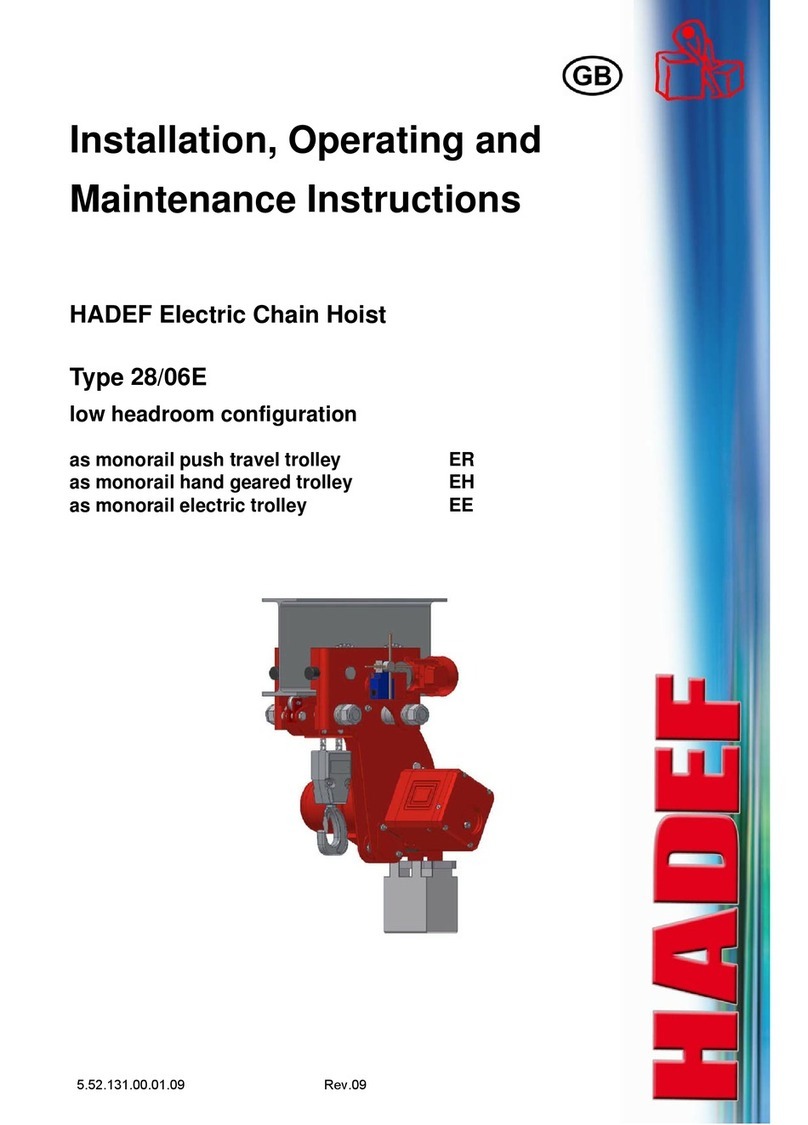
HADEF
HADEF 28/06E Installation, operating and maintenance instructions

VEVOR
VEVOR GZB88057-CD1000LBS user manual
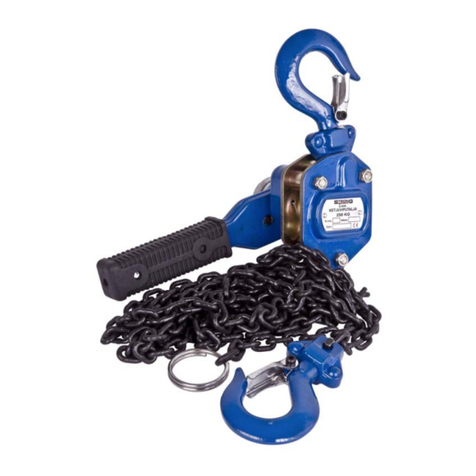
IKH
IKH StrongLine XK0250 instruction manual

Powerfix Profi
Powerfix Profi 306852 Operating and Safety Instructions, Translation of Original Operating Manual
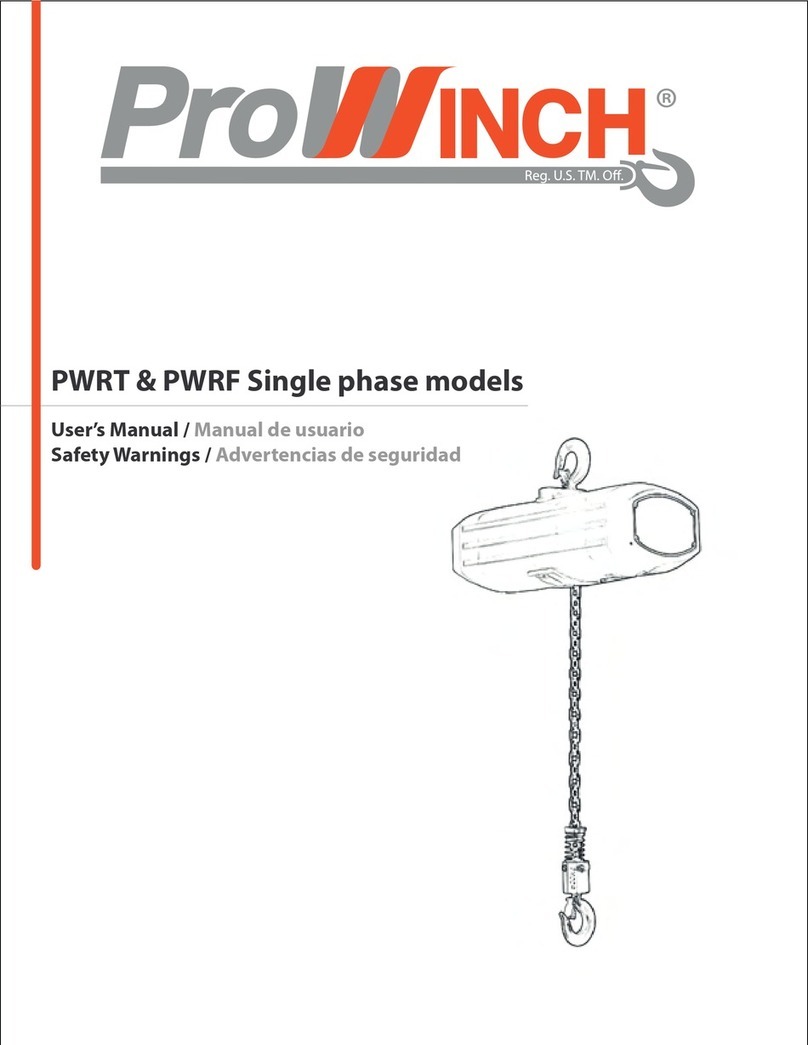
Prowinch
Prowinch PWRF1000 user manual

Parkside
Parkside PSZ 250 A1 Operation and safety notes translation of the original instructions
